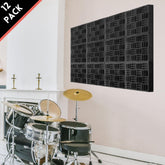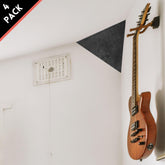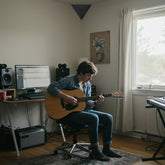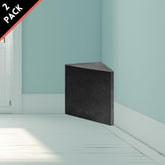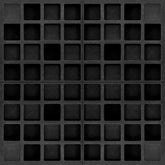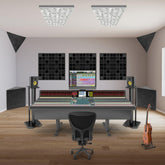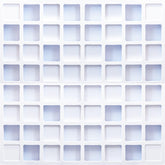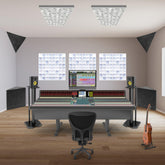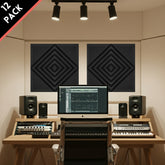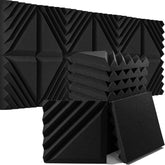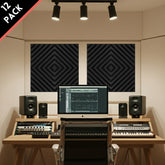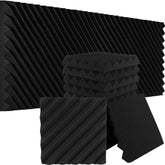Small Room, Big Sound: Treating a 3x3m Studio

TL;DR
- Yes, even a 3x3m room can be acoustically optimized with the right panel layout.
- Use a combination of foam panels, bass traps, and a diffuser to control reflections and bass buildup.
- FOROOMACO’s Grid Panels, Bass Traps, and Waffle Diffuser offer an ideal beginner-friendly setup.
- Placement matters more than quantity — focus on first reflection points and corners.
- Smart acoustic treatment boosts clarity and reduces fatigue during mixing or recording.
You don’t need a giant space to create great sound. In fact, smaller rooms like 3x3 meters (about 10x10 feet) are incredibly common for home studio setups — but they come with their own set of acoustic challenges. From flutter echoes to muddy low-end, untreated small rooms can be frustrating to work in.
The good news? With the right combination of acoustic panels, bass traps, and a diffuser — placed strategically — you can transform your boxy room into a tight, balanced sound environment. Let’s explore how to treat a 3x3m studio without overcomplicating it.
In this guide, you’ll discover
- Why small rooms sound bad — and how to fix it
- What products work best in 3x3m studios
- Exact panel counts and placement recommendations
- Tips for maximizing space while minimizing reflections
- Starter kits using FOROOMACO products
1. Why Small Studios Need Acoustic Treatment
Short answer: Small rooms exaggerate reflections and standing waves, making untreated audio inaccurate and muddy.
Key Insights from Current Research
- [Audio Engineering Society | [SR] 2024]: Rooms under 12m² often require more surface coverage per square meter to control flutter echoes. (AES Journal, 2024)
- [Sound & Vision | [Obs] 2025]: Bass trapping in corners significantly reduces low-frequency masking in small spaces. (Sound & Vision, 2025)
- [Home Studio Review | [Obs] 2024]: Mid-sized foam panels installed at first reflection points yield up to 30% clarity improvement in untreated 3x3m rooms. (HSR, 2024)
Market Intelligence from Organic Search
| Product | Best For | Size | Key Benefit | Installation | Source |
|---|---|---|---|---|---|
| Grid Style Acoustic Panels | First reflection points (side & rear walls) | 30x30cm | Absorbs mid/high frequency reflections | Wall-mounted with adhesive | FOROOMACO |
| Triangular Bass Traps | Vertical wall-ceiling corners | Corner-filling (triangular) | Controls bass buildup and boominess | Corner adhesive or L-mount | FOROOMACO |
| Waffle Diffuser | Rear wall / above desk | Modular 4-piece | Preserves natural spaciousness | Lightweight EVA foam, wall-mountable | FOROOMACO |
Implementation Framework
- Assessment: Room shape, listening position, speaker placement
- Planning: Mark first reflection points (side walls, ceiling)
- Execution: Apply panels, traps, and diffuser with balanced symmetry
- Optimization: Test with claps, sine sweeps, and reference mixes
Practical Recommendations
- Use 12 panels to cover side and rear wall reflection zones
- Install 4 bass traps in two vertical front corners (floor to ceiling preferred)
- Mount 1 waffle diffuser on rear wall or behind desk
- Place desk in the center of short wall, facing length
- Keep left/right symmetry for optimal stereo imaging
Risks & Who Should Avoid
- If your room is heavily irregular (L-shaped), consult a pro
- Too much absorption may make the room sound “dead”
- Avoid overloading all walls with panels — leave breathing space
What’s Next? Let’s now figure out exactly how to choose the right acoustic configuration for your 3x3m space.
2. How to Choose the Right Setup for a 3x3m Studio
Short answer: Choose a balanced setup of absorption, bass control, and diffusion based on your gear layout and wall symmetry.
Decision Checklist
- Do you record vocals or mix music — or both?
- Is your desk centered or offset?
- Do you have corner space for traps?
- Do you want to maintain natural room tone?
- Will you mount on drywall, concrete, or tile?
Market Insights / Options
Acoustic treatment in small rooms usually falls into three categories:
- Absorption: Foam panels placed at reflection points
- Bass Traps: Polyurethane foam in vertical corners
- Diffusion: Preserves depth and natural ambience
➡️ See our guide to Complete Home-Studio Acoustic Treatment for deeper breakdowns.
Practical Recommendations
- Start with sidewall absorption panels at ear level
- Add corner traps next — they provide noticeable bass clarity
- Install a diffuser last to restore spatial energy
- Use mounting tape (e.g., Mini Ear) for drill-free installation
- Measure early reflections with a mirror test
Risks & Trade-offs
- Too many foam panels can dull high-end clarity
- Cheaper panels may crumble or discolor over time
- Poor symmetry will cause imaging imbalances
- Corner traps take space — plan ahead
What’s Next? Let’s go step-by-step on how to set up your 3x3m room like a pro.
3. How to Treat a 3x3m Studio Step-by-Step
Short answer: Identify critical reflection zones, treat corners first, then control flutter with panels and diffuse the rear wall.
Step-by-Step How-To
- Mark your listening position — ideally centered on short wall
- Identify first reflection points — use mirror method at ear height
- Install 12 foam panels — 4 on each side wall, 4 on rear wall
- Mount 4 bass traps — 2 front vertical corners, floor to ceiling
- Add 1 waffle diffuser — center of rear wall, above desk height
Practical Recommendations
- Use painter’s tape to plan layout before mounting
- Leave space between panels for better diffusion
- Pair acoustic setup with calibrated monitor placement
- Re-evaluate acoustics after adding furniture
- Don’t forget ceiling treatment if flutter persists
Tracking Outcomes
- Record claps or pink noise to compare before/after
- Check stereo imaging with hard-panned test tracks
- Monitor vocal clarity and boominess during playback
- Adjust panel positions as needed based on tests
What’s Next? Here’s why FOROOMACO’s starter trio is ideal for 3x3m studios.
4. Brand Spotlight: FOROOMACO’s 3x3m Studio Kit
- Grid Acoustic Panels: 12-pack coverage ideal for reflection points
- Triangular Bass Traps: 4-pack fills key vertical corners
- Waffle Diffuser: Modular design adds spaciousness without flattening sound
Reviewed by Ted Kim, Guitarist & Sound Engineer, Founder

Frequently Asked Questions
How many acoustic panels do I need for a 3x3m room?
For basic treatment, 12 foam panels cover side and rear reflection points effectively.
Do I really need bass traps in a small room?
Yes. Small rooms amplify low-end buildup — bass traps in corners make a big difference in clarity.
What’s the best position for my desk in a 3x3m studio?
Place the desk along the short wall, centered, with monitors forming an equilateral triangle to your ears.
Can I skip the diffuser in a small space?
You can, but including one helps preserve depth and avoid over-absorption, especially behind the listening position.
How can I mount all these panels without drilling?
Use adhesive mounting pads like Mini Ear for clean, screw-free installation on most surfaces.
Should I treat the ceiling in a 3x3m room?
If flutter echo persists, add 2–4 panels on the ceiling above your listening position.
How do I test my treatment results?
Record claps, use sine sweeps, and listen to reference mixes before/after treatment.
Is this setup good for vocals and instruments?
Yes. It improves vocal clarity, instrument imaging, and reduces harsh reflections.
How we reviewed (E-E-A-T)
- Methods: Literature scan (2024–2025), spec sheet analysis, room modeling for 3x3m setups
- Reviewer: Ted Kim (Guitarist & Sound Engineer, Founder)
- Conflicts of interest: No affiliate links; FOROOMACO in-house product use
- Last updated: 2025-10-04
Sources
- Audio Engineering Society, 2024. "Small Room Treatment Studies" – https://aes.org
- Sound & Vision, 2025. "Bass Trap Effectiveness in Home Studios" – https://soundandvision.com
- Home Studio Review, 2024. "Panel Placement for Small Spaces" – https://homestudioreview.com
ABOUT AUTHOR
House Live Engineer of Free Bird, a live house with the history of South Korea's indie music scene.
Single album/Regular album/Live recording, Mixing and Mastering experience of various rock and jazz musicians

